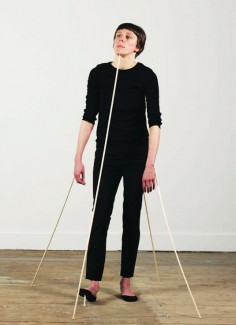Nicola Dale
Model for Ideology V

source: nicoladale
Nicola Dale’s sculptures visualise the acquisition of knowledge. She is intrigued by the irreversible transition from the materiality of books, libraries and institutionalised learning to the intangible data overload of the digital world. She examines the difference between knowledge and information and locates in each a source of potential and constraint – the resulting tension is both a conceptual motivation and an aesthetic objective.
Defying the ease, speed and perfection with which artworks can now be made digitally, Dale’s delicate sculptures revel in slow, human imprecision. She uses ephemeral or natural materials for their capacity to retain the impression of her imperfect touch. Underpinned by a rigorous attention to process, she investigates what her hands can achieve with minimal apparatus. Her work takes time.
Dale’s choice and manipulation of materials reacts against our depthless, screen-mediated world. Her engagement with manual processes and her focus on cut, curl and contour belie our diminishing sense of touch. Her pieces shiver with multiple focal points. They require the viewer’s eyes to move, scroll and refresh. They are defiantly positioned in real time and solid state.
.
.
.
.
.
.
.
source: saatchiart
Nicola Dale’s sculptures visualise the acquisition of knowledge. She is intrigued by the irreversible transition from the materiality of books, libraries and institutionalised learning to the intangible data overload of the digital world. She examines the difference between knowledge and information and locates in each a source of potential and constraint – the resulting tension is both a conceptual motivation and an aesthetic objective. Defying the ease, speed and perfection with which artworks can now be made digitally, Dale’s delicate sculptures revel in slow, human imprecision. She uses ephemeral or natural materials for their capacity to retain the impression of her imperfect touch. Underpinned by a rigorous attention to process, she investigates what her hands can achieve with minimal apparatus. Her work takes time. Dale’s choice and manipulation of materials reacts against our depthless, screen-mediated world. Her engagement with manual processes and her focus on cut, curl and contour belie our diminishing sense of touch. Her pieces shiver with multiple focal points. They require the viewer’s eyes to move, scroll and refresh. They are defiantly positioned in real time and solid state. Nicola Dale is supported by Mark Devereux Projects.
.
.
.
.
.
.
.
source: dailyserving
Webster’s definition of ideology is: “A system of ideas and ideals, especially one that forms the basis of economic or political theory and policy.” Artist Nicola Dale’s sculptures, performances, and installations are interpretations of this definition of ideology—one of many subjects that Dale explores in her work.
Dale often works on one subject or idea for an extended period, in distinctive bodies that incorporate various forms and approaches. Her ongoing series Models for Ideology is one such examination. Model for Ideology VI (2015) was a durational performance in which the artist—clad in black pants, shirt, and ballet socks—stood for an extended period with long, thin wooden dowels stuck under her foot, chin, arms, and hips, simultaneously forcing her into and supporting her in a contrapposto stance. The Models for Ideology create a series of support systems that constrain movement and make it precarious; ideologies work in the same way by creating a set of principles and expectations in which to operate but also struggle to extend beyond, systems which are durable and somehow always in flux.

